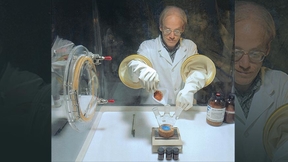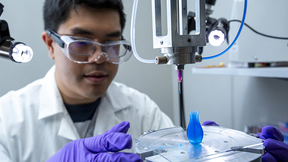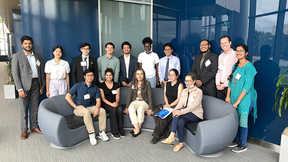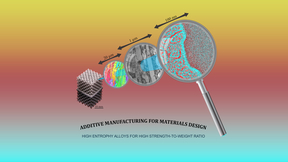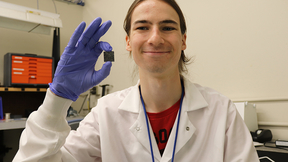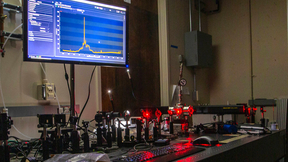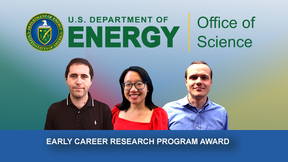Back
Advanced Materials and Manufacturing
From batteries to water purifiers, carbon nanotubes are where it’s at
Lawrence Livermore National Laboratory (LLNL) scientists are scaling up the production of vertically aligned single-walled carbon nanotubes (SWCNT) that could revolutionize diverse commercial products ranging from rechargeable batteries, automotive parts and sporting goods to boat hulls and water filters. The research appears in the journal Carbon. Most CNT production…
New method sheds light on solid-state battery fabrication
Safe, long-cycle-life batteries with high energy density are greatly needed with the rapid growth of electric devices and vehicles and grid energy storage demands. Lawrence Livermore National Laboratory (LLNL) scientists have devised a method for the fabrication of all-solid-state lithium metal batteries, which have been recognized as the future choice of safe and high…
Breaking up is easy to do with copper-titanium catalysts
Producing fragrances and flavorings and converting chemicals derived from biomass could get a boost from a new technique to break up hydrogen in nanoporous copper-titanium catalysts. The dissociation (breaking up) of hydrogen bonds is an essential elementary step in catalytic hydrogenation (a chemical reaction between molecular hydrogen [H2] and another compound or element…
PLS postdocs to compete in the 2022 Bay Area Research Slam
On September 20, LLNL hosted its annual Postdoc Research Slam. This Lab-wide competition encourages postdocs to showcase their research in a three-minute presentation that answers the question, “Why is my research important?” The event gives postdocs the opportunity to improve their communication and speaking skills and challenges them to articulate their research in an…
Developing technology to keep the nuclear stockpile safe, secure and reliable
The last nuclear test, code-named Divider, took place 30 years ago, on Sept. 23, 1992. That year, President Bush declared a temporary moratorium on nuclear testing, which became permanent in 1995, during the Clinton administration. This ending of the era of nuclear testing coincided with a Presidential announcement of the beginning of stockpile stewardship. As the decision…
LLNL hosts HBCU students, faculty in week-long outreach program
Lawrence Livermore National Laboratory (LLNL) hosted a group of students and faculty from Historically Black Colleges and Universities (HBCUs) for a week in June to promote internships, job opportunities and career paths at LLNL. Judging from the group’s reaction and feedback, the inaugural week-long HBCU tour was a clear success and made a positive impression on the…
Livermore researchers collect three awards among the top 100 industrial inventions
Lawrence Livermore National Laboratory (LLNL) scientists and engineers have garnered three awards among the top 100 industrial inventions worldwide. The trade journal R&D World Magazine recently announced the winners of the awards, often called the “Oscars of invention,” recognizing new commercial products, technologies and materials that are available for sale or…
LLNL and Korea Institute of Science and Technology to collaborate
Leaders at Lawrence Livermore National Laboratory (LLNL) and the Korea Institute of Science and Technology (KIST) signed a memorandum of understanding (MOU) on Monday to collaborate on basic science and technology in the renewable energy, climate science, data science and characterizations arenas. Under the MOU, KIST will have office space in the Livermore Open Campus…
LLNL and Case Western Reserve University to continue collaboration
The leaders of Case Western Reserve University and Lawrence Livermore National Laboratory (LLNL) signed a memorandum of understanding (MOU) to accelerate their efforts in shared areas of excellence. After three years of growing institutional collaboration in such areas as energy, materials science and polymer processing, Case Western Reserve President Eric W. Kaler…
Graphite changes to hexagonal diamond in picoseconds
The graphite-diamond phase transition is of particular interest for fundamental reasons and a wide range of applications. On very fast compression time scales, material kinetics hinder the transition from graphite to the equilibrium cubic diamond crystal structure that we commonly know as diamond. Shock wave compression of graphite typically requires pressures above 50 GPa…
New class of 3D-printed alloys brings more flexibility to super-strong metal parts
Metal 3D printing is used to produce components for many commercial applications, particularly in the transportation sector, where printing methods such as laser powder bed fusion (L-PBF) can produce super-strong and ultralight complex-shaped components that cannot be manufactured with conventional techniques. But while laser-based methods enable the manufacturing of…
Research finds mechanically driven chemistry accelerates reactions in explosives
Scientists at the Lawrence Livermore National Laboratory (LLNL) Energetic Materials Center and Purdue University Materials Engineering Department used simulations performed on the LLNL supercomputer Quartz to uncover a general mechanism that accelerates chemistry in detonating explosives critical to managing the nation’s nuclear stockpile. Their research is featured in the…
Fabricating iron oxide with high phase purity
Various types of iron oxide (FeO) are typically distinguished by the number of iron and oxygen atoms coordinated with one another. However, specific iron and oxygen coordination is also an important factor to consider, as a molecule’s various phases can exhibit vastly different material properties. In recent years, epsilon-phase iron oxide (ε-Fe2O3), a rare polymorph of…
3D printing of transparent silicone elastomers
Additive manufacturing is essential to the production of advanced materials, providing a straightforward approach to rapid prototyping and manufacturing. Direct ink writing (DIW), a subset of additive manufacturing, offers a versatile route to ink extrusion—a processing method where a viscous ink is forced through a nozzle but behaves like a solid when printed on a…
LLNL intern fabricates carbon aerogel structures for energy-storage applications
A visit to Lawrence Livermore National Laboratory (LLNL) last summer by a university professor led to a unique internship opportunity for an undergraduate student this summer: helping LLNL scientists fabricate higher-performing carbon aerogel structures for electrodes and other energy-storage applications. In 2021, Professor Anthony Santamaria from Western New England (WNE…
Oxygen effects on uranium tested
A team of researchers from Lawrence Livermore National Laboratory (LLNL) and the University of Michigan has found that the rate of cooling in reactions dramatically affects the type of uranium molecules that form. The team’s experimental work, conducted over about a year-and-a-half starting in October 2020, attempts to help understand what uranium compounds might form in…
Physics-based cryptocurrency transmits energy (not just information) through blockchain
Researchers from Lawrence Livermore National Laboratory (LLNL) have devised a physics-based cryptocurrency that links electrical energy and blockchain technologies in a new way. This new blockchain concept, dubbed “E-Stablecoin,” could allow electricity to be transmitted between users who are spread around the world, without the need for interconnecting wires or a grid…
DOE honors three early-career Lab scientists
Three scientists from Lawrence Livermore National Laboratory (LLNL) are recipients of the Department of Energy’s (DOE) Office of Science Early Career Research Program award. Mimi Yung, John Despotopulos and Timofey Frolov are among 83 awardees receiving the recognition. Under the program, typical awards for DOE national laboratory staff are $500,000 per year for five years…
Additive Manufacturing Brings New Possibilities for Transparent Ceramics
Having developed several transparent ceramics for radiation detection applications for the Department of Homeland Security and the Stockpile Stewardship Program, Lawrence Livermore recently leveraged its unique additive manufacturing resources and capabilities to develop transparent ceramics with properties not previously available for use as laser materials.
Three Lab postdocs selected to attend the 71st annual Lindau Nobel Laureate meeting
Three Lawrence Livermore National Laboratory (LLNL) postdoctoral appointees have been selected to attend the 71st annual Lindau Nobel Laureate meeting in Germany this summer thanks to the University of California President’s 2022 Lindau Nobel Laureate Meetings Fellows Program. The three selected to attend are Magi Mettry, Johanna Schwartz and Dane Sterbentz. The Lindau…






